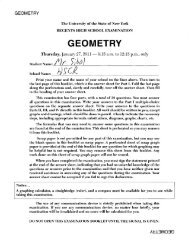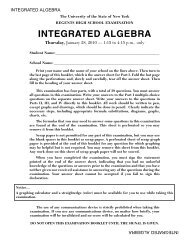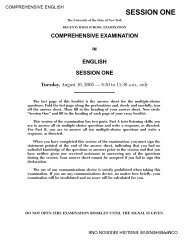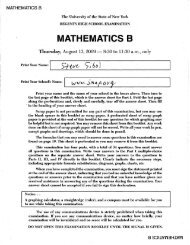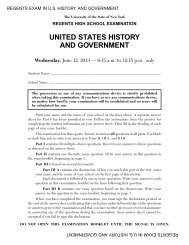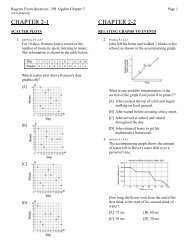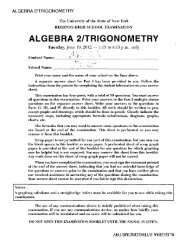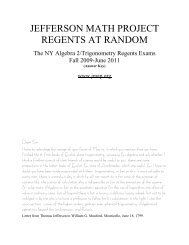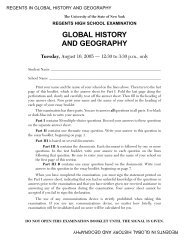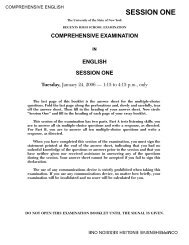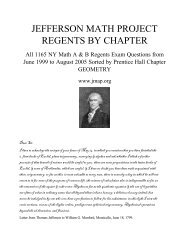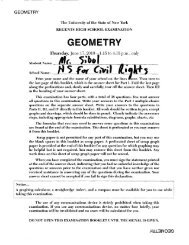G.G.31: Isosceles Triangle Theorem 1: Investigate, justify ... - JMap
G.G.31: Isosceles Triangle Theorem 1: Investigate, justify ... - JMap
G.G.31: Isosceles Triangle Theorem 1: Investigate, justify ... - JMap
You also want an ePaper? Increase the reach of your titles
YUMPU automatically turns print PDFs into web optimized ePapers that Google loves.
Regents Exam Questions G.<strong>G.31</strong>: <strong>Isosceles</strong> <strong>Triangle</strong> <strong>Theorem</strong> 1 Name: ________________________<br />
www.jmap.org<br />
G.<strong>G.31</strong>: <strong>Isosceles</strong> <strong>Triangle</strong> <strong>Theorem</strong> 1: <strong>Investigate</strong>, <strong>justify</strong>, and apply the isosceles triangle<br />
theorem and its converse<br />
1 If the vertex angles of two isosceles triangles are<br />
congruent, then the triangles must be<br />
1) acute<br />
2) congruent<br />
3) right<br />
4) similar<br />
2 In the diagram of ABC below, AB ≅ AC. The<br />
measure of ∠B is 40°.<br />
What is the measure of ∠A?<br />
1) 40°<br />
2) 50°<br />
3) 70°<br />
4) 100°<br />
1<br />
3 In the diagram below of ABC, AB ≅ AC,<br />
m∠A = 3x, and m∠B = x + 20.<br />
What is the value of x?<br />
1) 10<br />
2) 28<br />
3) 32<br />
4) 40<br />
4 In the diagram below, LMO is isosceles with<br />
LO = MO.<br />
If m∠L = 55 and m∠NOM = 28, what is m∠N?<br />
1) 27<br />
2) 28<br />
3) 42<br />
4) 70
Regents Exam Questions G.<strong>G.31</strong>: <strong>Isosceles</strong> <strong>Triangle</strong> <strong>Theorem</strong> 1 Name: ________________________<br />
www.jmap.org<br />
5 In ABC, AB ≅ BC. An altitude is drawn from B<br />
to AC and intersects AC at D. Which conclusion is<br />
not always true?<br />
1) ∠ABD ≅ ∠CBD<br />
2) ∠BDA ≅ ∠BDC<br />
3) AD ≅ BD<br />
4) AD ≅ DC<br />
6 In isosceles triangle ABC, AB = BC. Which<br />
statement will always be true?<br />
1) m∠B = m∠A<br />
2) m∠A > m∠B<br />
3) m∠A = m∠C<br />
4) m∠C < m∠B<br />
7 In the diagram below of ACD, B is a point on AC<br />
such that ADB is an equilateral triangle, and<br />
DBC is an isosceles triangle with DB ≅ BC. Find<br />
m∠C.<br />
2<br />
8 In the diagram below of GJK, H is a point on GJ,<br />
HJ ≅ JK , m∠G = 28, and m∠GJK = 70.<br />
Determine whether GHK is an isosceles triangle<br />
and <strong>justify</strong> your answer.<br />
9 In RST, m∠RST = 46 and RS ≅ ST. Find<br />
m∠STR.
G.<strong>G.31</strong>: <strong>Isosceles</strong> <strong>Triangle</strong> <strong>Theorem</strong> 1: <strong>Investigate</strong>, <strong>justify</strong>, and apply the isosceles triangle<br />
theorem and its converse<br />
Answer Section<br />
1 ANS: 4 REF: 061124ge<br />
2 ANS: 4<br />
180 − (40 + 40) = 100<br />
REF: 080903ge<br />
3 ANS: 2<br />
3x + x + 20 + x + 20 = 180<br />
5x = 40<br />
REF: 081222ge<br />
4 ANS: 1<br />
x = 28<br />
REF: 061211ge<br />
5 ANS: 3 REF: 011007ge<br />
6 ANS: 3 REF: 061004ge<br />
7 ANS:<br />
REF: 011129ge<br />
8 ANS:<br />
No, ∠KGH is not congruent to ∠GKH.<br />
REF: 081135ge<br />
1<br />
ID: A
9 ANS:<br />
180 − 46<br />
67. = 67<br />
2<br />
REF: 011029ge<br />
2<br />
ID: A



